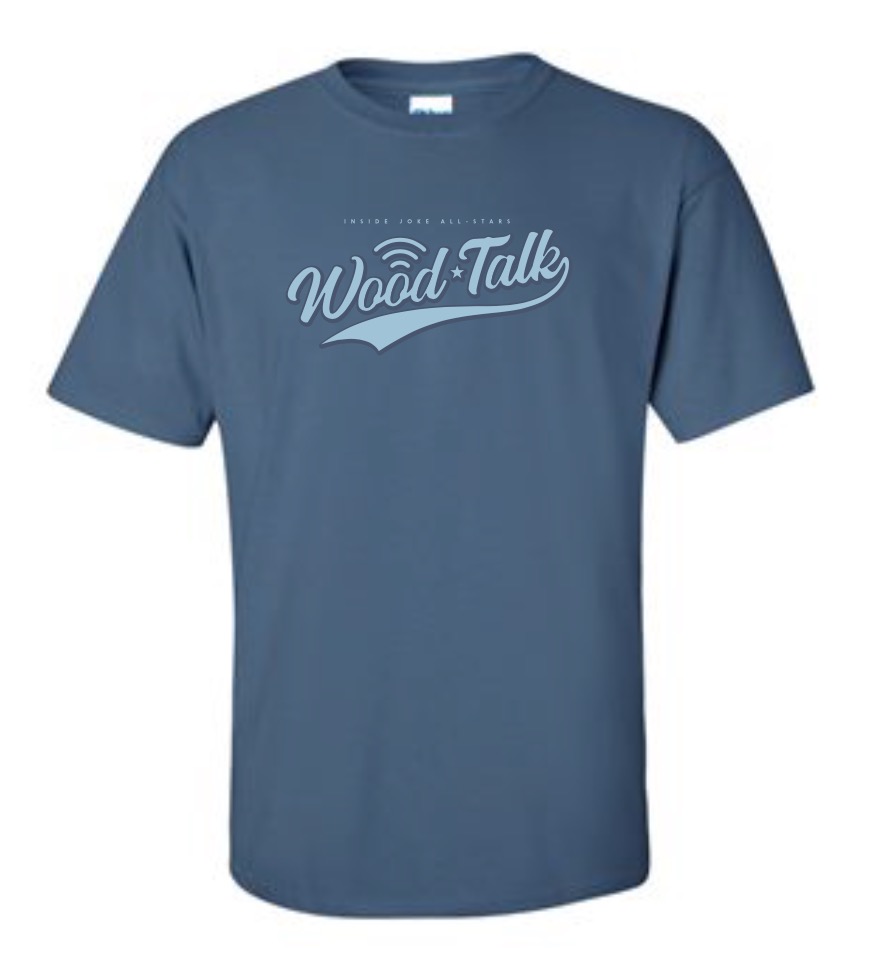Get your Wood Talk T-Shirt today!
On today’s show, we’re talking about solvent confusion, box joints and short ceilings, workbenches and T tracks, and selecting wood for your projects.
What’s on the Bench?
– Marc is doing NOTHING!
– Matt made a lamp shade.
– Shannon is finishing a bed!
What’s New
Poll of the Week
– How do you edge joint boards?
– Do you build holiday-themed projects?
Voicemail
– Kyle has a new table saw and is trying to prevent burning.
– Brian is confused by all of the solvents available today.
– Jon is looking for a way to make joints on the ends of long workpieces.
– Nick is wondering about T-track clamping options for a workbench. Shannon recommends this. Marc mentioned Leigh Jigs hold-down clamps.
– Bob is curious how we select wood for our projects.
Reviews and Thanks!
Are you interested in setting up a recurring donation to help support the show? Use the links in the left column! We’d like to thank DepreciationWorks and James Randolph as well as everyone else for their continued support.
Don’t forget to leave us a kick-butt review in the iTunes Store.

8 replies on “WT202 – Do Less Woodworking!”
It seems like the simplest way to cut finger joints/box joints on long boards would be to tip the router table on its back or mount the router horizontally. Maybe you guys mentioned it and I missed it, but I wanted to bring it up just in case you didn’t.
Thanks for the great podcast!
Nick, here is an alternate to the T-track and Kreg/Leigh holddowns:
Festool still has the tops for the discontinued MFT1080. Festool 489396 Perforated Plate – Amazon for $120. 45″ x 28″, 2 of them side-by-side (short ends) give you an almost 8′ long 28″ wide workbench. These have a 20mm grid of holddown holes, I believe about 95mm apart. You can then use all the various Festool clamps and holdfasts.
If you already have a good workbench top, simply make a rabbeted hardwood frame about 3-4″ high from 5 or 6 quarter Maple or whatever for the MFT tops to sit flush in, and secure the new top on top of the old, either permanently or temporarily. I did this with an old sturdy but ragged-top workbench in our retirement village shop in FL. You now have a brand-new flat top workbench, with a complete grid for holddowns, and with the sturdyness of your original bench (or better). And ‘no worries’ of T-track pull-out. Plus a top that can be ‘flipped’ when worn on the first side.
While I bored a matching set of 20mm holes horizontally in the frame, you could instead use a T-track all around – much like the original MFT.
I also did another smaller one where I bored the 20mm grid myself in standard Home Center 3/4 MDF. For $120 – I would not do it again. The Festool MDF seems a much tougher and water-resistant breed. And my grid was not as precise. (for squaring etc.)
Boards will also burn on the tablesaw if they are not flat or if the edge riding the fence is not jointed. Either of those could cause enough binding to result in burn marks. Some species are more prone to burning than others (i.e. cherry always seems to burn a little). If it continues to be a problem a dedicated rip blade with fewer teeth and deeper gullets might help.
Although I don’t own one, it would seem that a dovetail jig would work to cut the finger joints. Use the top mounting plate with a bearing and a straight bit instead of a dovetail bit. Minor cleanup with a chisel would be needed because the straight bit would leave rounded “webs” at the bottom of the fingers.
But he’d still have a vertical clearance issue, unless he can come up with a safe way to run the jig on its side.
Since your using box joints why not figure out how to cut your project into 2 and box joint the 2 pieces back together. Cutting in 2 will allow you to joint all ends.
I saw an artical or documentary a couple of years ago, cant remember which. It went in depth on how it was buried in the bog in NZ and how it sat there over the years absorbing minerals causing the grain to be very pronounced. I can imagine how this would cause this wood to be rather hard on cutting blades. That said, I still want to buy some.
This is a little late for the box joint discussion, I just listened to this episode last night on a flight back to the states, so sorry for the late addition that probably won’t be read. But why not use a slot cutter or T&G bit on the router table and adjust the height for each pass? You could batch each of the cuts by ganging up the boards, reinforce the back to prevent blowout, a use practice pieces to ensure the slots/fingers are in the exact correct position. You wouldn’t have to do anything crazy with the router this way.
Cheers,
JW